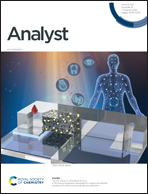Deep learning for ‘artefact’ removal in infrared spectroscopy†
Abstract
It has been well recognized that infrared spectra of microscopically heterogeneous media do not merely reflect the absorption of the sample but are influenced also by geometric factors and the wave nature of light causing scattering, reflection, interference, etc. These phenomena often occur simultaneously in complex samples like tissues and manifest themselves as intense baseline profiles, fringes, band distortion and band intensity changes in a measured IR spectrum. The information on the molecular level contained in IR spectra is thus entangled with the geometric structure of a sample and the optical model behind it, which largely hinders the data interpretation and in many cases renders the Beer–Lambert law invalid. It is required to recover the pure absorption (i.e., absorbance) of the sample from the measurement (i.e., apparent absorbance), that is, to remove the ‘artefacts’ caused merely by optical influences. To do so, we propose an artefact removal approach based on a deep convolutional neural network (CNN), specifically a 1-dimensional U-shape convolutional neural network (1D U-Net), and based our study on poly(methyl methacrylate) (PMMA) as materials. To start, a simulated dataset composed of apparent absorbance and absorbance pairs was generated according to the Mie-theory for PMMA spheres. After a data augmentation procedure, this dataset was utilized to train the 1D U-Net aiming to transform the input apparent absorbance into the corrected absorbance. The performance of the artefact removal was evaluated by the hit-quality-index (HQI) between the corrected and the true absorbance. Based on the prediction and the HQI of two experimental and one simulated independent testing datasets, we could demonstrate that the network was able to retrieve the absorbance very well, even in cases where the absorbance is completely overwhelmed by extremely large ‘artefacts’. As the testing datasets bear different patterns of absorbance and ‘artefacts’ to the training data, the promising correction also indicated a good generalization performance of the 1D U-Net. Finally, the reliability and computational mechanism of the trained network were illustrated via two interpretation approaches including a direct visualization of layer-wise outputs as well as a saliency-based method.



 Please wait while we load your content...
Please wait while we load your content...